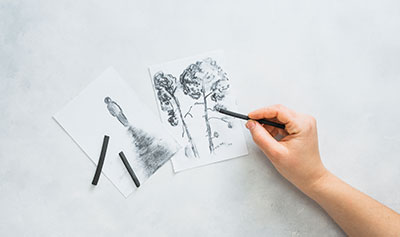Haven’t we all, at least once in our life, come across someone explaining something to us by drawing/doodling? Even during meetings and presentations, the help of circles, boxes, and arrows are sought to convey the message. This practice of resorting to pencil sketches and doodles to understand the concept is sketchnoting in a layman’s parlance. As per Ignitepad, sketchnoting is an interesting way to generate interest or express an idea.
What exactly is the concept of sketchnoting?
Sketchnoting can be defined as a method of using visuals in a form of sketching and doodling to comprehend a thought, expression, concept, or idea while listening to it as a lecture. The process involves listening to the concept, processing it, and noting it down in the form of pencil sketches for a glance and easy comprehension later.
The way learners transfer the information processed onto their notebook or to others is the key and the prime focus. Apart from listening, learners could access the information by watching, reading, or discussing. Sketching is always fun, when it is with the purpose it becomes all the more interesting. Sketchnoting can be used during coding classes too.
Even teachers can prepare notes for online courses for kids using sketchnoting. By using this art of employing arts to teach students they can send their thoughts across. Some people may find it stressful, but remember sketchnoting is not about perfection it is purely about art.
The need to sketchnote
Sketchnoting opens up the brain of the learner enabling holistic development. By incorporating visuals in the notes a learner activates otherwise dormant components of their brain, especially during kids' online classes. The powerful combination of visuals and texts makes the concept easy to understand, hence could be easily explained further.
Sketchnoting also enhances retention, recall value, and improves the power to concentrate. The multi-sensory task improves fine motor skills too, mainly during online courses-language. Sketchnoting develops learners’ creative skills. It develops their art of drawing and keeps them happy and healthy. The psychological aspects of sketchnoting are calming effect, relaxing power, and a mindful presence.
How can it be done?
There are many ways through which sketchnoting can be carried out.
∙ Can be done using digital or analog methods
∙ Paper and pencil are also fine for pencil sketch noting if you want to keep technology at bay
∙ Some may prefer doing it using their iPad.
∙ Popular apps can also be used that will enable reorganizing, editing, and erasing
∙ Doodling using technology can be fun as you can zoom in and zoom out your pencil sketches
∙ It can be done online too without having to download any app
Teachers must support
Teachers must support their students in sketchnoting by suggesting innovative ways to do it. They can also join their students in sketchnoting. Watching their teacher drawing, students with no interest in sketching or drawing will feel motivated. It will boost their confidence. Make your students understand that it does not require them to be an artist. All they need to do is express the idea the way they understand it. If the sketchnotes you created make you or your friends laugh, it is all the more beneficial as it invokes laughter. It also means that you figured out the imperfections yourself and will be able to improvise them. It is a kind of self-analysis.
If you are a learner and you intend to use sketchnoting for your lectures but can hardly draw, note that Ignitepad offers online classes on sketching for beginners!
Also, Read:
Amazing Benefits of Drawing for Kids


